

The Index invites paper proposals for two sessions at the 2018 Medieval Congress in Medieval Studies at Kalamazoo, on the theme of “Iconography and Its Discontents.”
Modern scholars often express discomfort with the term “iconography,” caricaturing its study as obsessed with rigidified taxonomies, elaborate stemmae, and the abstract pursuit of textual analogues for free-floating images. Yet the fundamental questions that drive iconographic studies remain central to scholarship in art history and many other medievalist disciplines. What did a medieval image mean, and to whom? How did these meanings change in different contexts and in the eyes of different viewers, and what can this tell us about the values and practices of the society in which they were made and viewed? The ways in which researchers answer these questions, meanwhile, has changed dramatically, bolstered by new methodologies and the increasing availability of digital tools to quantify, compare, and analyze a wide range of medieval images. Such advances suggest that the study of iconography not only is “not dead yet,” but is very much alive and open to reassessment.
Our two sessions capitalize on the new vitality of current iconographic studies by gathering papers that reexamine the potential of iconographic work for medievalists, prioritizing work that pushes past traditional approaches to engage with the new questions, new methods, new disciplines, and new technologies of greatest impact within the field. Following on the centennial and digital relaunch of Princeton’s recently renamed Index of Medieval Art, one of the first and longest-lived iconographic repositories of its kind, the session aims to chart a new path in a scholarship transformed by both technological advancements and disciplinary creativity.
Session I: Iconography and/as Methodology. What questions do today’s scholars ask of medieval images, and what approaches do they take to answering them? Do their efforts represent a break with the past or a continuation of it? What disciplines do they most engage? For this panel, we invite papers that explore the impact of new methods, whether from art history or from other disciplines, on modern understanding of how medieval images did their work for their makers and viewers. Papers that assess the relevance or revision of past approaches are also welcome.
Session II: Iconography and Technology. How have digital resources transformed the ways in which scholars approach the study of medieval images and their meaning? What new questions (and answers) are now possible, and what remains the same? For this panel, we seek papers that evaluate the impact of online collections, databases, and other digital tools on image-based scholarship in any discipline. Both case studies and broader analyses are invited.
Proposals are invited from scholars at all levels and in any relevant discipline. To submit, please send a Participant Information Form (https://wmich.edu/medievalcongress/submissions) and one-page abstract to:
Pamela A. Patton, Director
Index of Medieval Art
A7 McCormick Hall
Princeton University
Princeton, NJ 08544-1018

The month of June marks the passing of two historically consequential rulers: the fourth-century Roman emperor Julian, posthumously referred to as Julian the Apostate, and the twelfth-century Holy Roman Emperor Frederick I, also known as Frederick Barbarossa. Their untimely deaths shocked the Late Antique and Medieval worlds, respectively. On June 26, 363, Julian was mortally wounded in the battle of Samarra during a Roman military campaign against the Persians. According to various sources, a spear delivered by a member of the Sassanian cavalry pierced his liver, and he subsequently died from the mortal blow some three days later. June 10, 1190, marks the day on which Frederick Barbarossa drowned in the Saleph River (the Göksu in modern Turkey) in the middle of the Third Crusade, the Latin West’s attempt to recapture the Holy Land from Saladin. The deaths of both leaders in the middle of critical military campaigns generated either anxiety or derision among their contemporaries, as underscored in subsequent medieval representations of the two emperors.
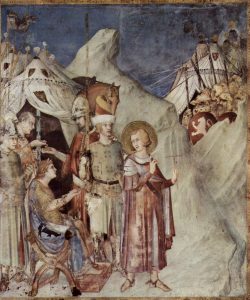
Posthumous medieval representations of Julian, the last Roman emperor who championed paganism, are almost always critical. For example, a lavishly illuminated ninth-century Byzantine manuscript of Gregory Nazianzen’s homilies (Paris, BnF, gr.510, fol. 374v), depicts the ruler accompanying the pagan philosopher Maximus of Ephesus and venerating idols. In Simone Martini’s fourteenth-century fresco cycle in the Chapel of Saint Martino within the Lower Church of San Francesco in Assisi, the figure of Julian the Apostate serves as an arrogant, pagan, visual foil to the saintly Martin of Tours, who is shown renouncing military life for his Christian beliefs. Depictions of Julian’s death are even more damning. By the early sixth century, accounts surrounding Julian’s death shifted away from a battle against the Persians and amplified the legend of Saint Mercurius (identified as Mercurius of Caesarea in the Index database), a Byzantine soldier saint who rises from the dead and kills the pagan emperor with his lance or sword.
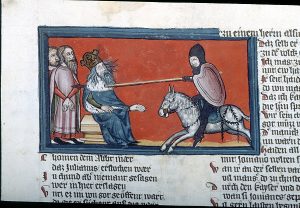
Although this legend developed in Eastern sources, it grew in popularity in the Medieval Latin West, even making an appearance in Jacopo de Voragine’s thirteenth-century Golden Legend. In a fourteenth-century Christherre-Chronik miniature in the Morgan Library (New York, PML, M.769, fol. 327v), the figure of Julian is portrayed as an elderly medieval monarch lanced by a fully armored Saint Mercurius astride a galloping horse.

In contrast to the overwhelmingly uncomplimentary medieval portraits of Julian the Apostate, representations of Frederick Barbarossa generally evoke the idea of imperial majesty and power. The so-called Cappenberg head (c. 1160), a reliquary that originated as a portrait of Frederick, effectively conveys an image of grandeur and stability through its precious materials and antique visual language. Yet a miniature drawn, less than a decade after his death, in Peter of Eboli’s De Rebus Sicilis (Bern, Stadtbibliothek, 120 II, fol. 107r) betrays the unease surrounding the emperor’s accidental passing. Inscribed FREDERICUS IMPERATOR IN FLUMINE DEFUNCTUS, the drawing depicts the ruler falling off his horse and drowning in the water, his crown lying ignobly in the riverbed. As if to combat the contemporary whispers that Frederick died without confessing his sins, the illuminator purposely included an image of the ruler’s soul as a swaddled infant held aloft by an angel and given to the Hand of God emerging from heaven. In so doing, the artist was participating in a larger, concerted effort to salvage Frederick Barbarossa’s reputation for posterity as a noble and most Christian emperor.
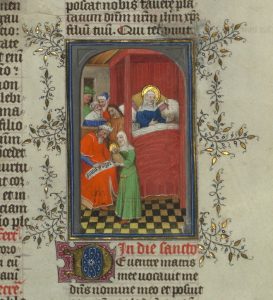
Zacharias writing John’s name at his nativity, Missal of Eberhard von Greiffenklau (Walters MS W. 174, fol. 191r)
Over the next few weeks, friends and users of the Index will see signs of our gradual shift to a new name, The Index of Medieval Art. This revision was undertaken after careful thought and consultation with Princeton faculty, students, administration, and the wider scholarly community.
The change reflects the broad evolution of our institution’s scope and mission since its founding in 1917, when its work was limited to cataloguing religious themes and subjects in early Christian art up to 700 C.E. A century later, our records have expanded to encompass both religious and secular imagery, including Jewish and Islamic works, from the first centuries of the Common Era until the sixteenth century. The scholarly activities that we support and generate have also evolved over the years, reflecting the broad interpretive and interdisciplinary analysis that has become fundamental to the study of medieval images. Our new name signals more accurately our expanded holdings, mission, and goals, as well as our institution’s broad potential to serve researchers in multiple fields of study.
If you have already bookmarked our Facebook and Twitter accounts using their original URLs, you’ll be redirected to the correct ones and shouldn’t notice an interruption. The new URLs for the sites appear below. In the coming months, we will also implement new URLs for this website and our redesigned database, which is set to launch in September 2017. We look forward to sharing news of those changes with you soon!
Facebook: www.facebook.com/imaprinceton/
Twitter: @imaprinceton
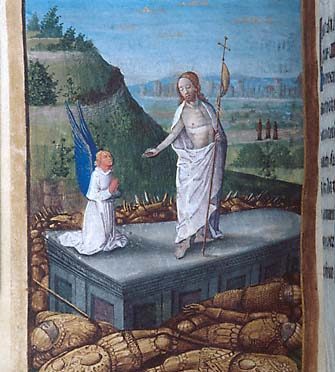
From the Gospel of Matthew, 27:62-66, Douay-Rheims: And the next day…the chief priests and the Pharisees came together to Pilate, saying: Sir, we have remembered, that that seducer said, while he was yet alive: After three days I will rise again. Command therefore the sepulchre to be guarded until the third day: lest perhaps his disciples come and steal him away, and say to the people: He is risen from the dead; and the last error shall be worse than the first. Pilate saith to them: you have a guard; go, guard it as you know. And they departing, made the sepulchre sure, sealing the stone, and setting guards.
Of the four Evangelists, Matthew alone records the above conversation among Pilate, the chief priests and the Pharisees, the latter two being concerned that Christ would emerge from the tomb to continue stirring up the people. To which Pilate responded, well, then guard the tomb. He had already washed his hands of the matter, yet here it is again. So, just guard the tomb, and (reading between the lines) leave me out of it. This episode also appears in the apocryphal gospel of Peter, where the story follows the same thread.
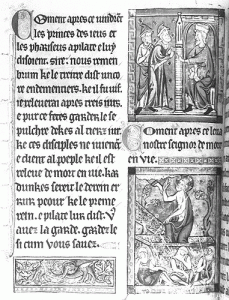
1. Miscellany, 1280-1299, Cambridge, St. John’s College, MS K.21. The upper image shows two high priests or Pharisees before Pilate expressing their concern that the tomb be guarded. Below, Christ stands in a sarcophagus; three soldiers sit in front of it. The text in the left column relates the story.
Christ’s resurrection appears in the Index of Christian Art 500+ times in multiple media; the order to set the guard is represented only sixteen times. The Cambridge Miscellany (Fig. 1) presents the thread of the story well, with the text in the left column, and in the right, a miniature with two figures petitioning Pilate, above a resurrection image with soldiers.
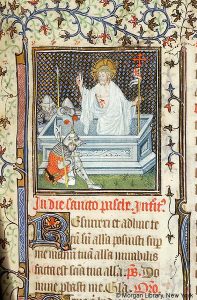
2. Châlons Missal, c. 1400, New York, Morgan Library, MS M.331, fol. 130r. Three soldiers surround a sarcophagus, one leaning on the back side of the tomb.
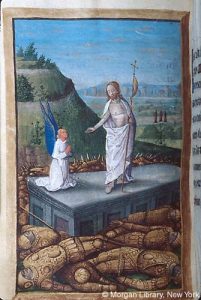
3. Hours of Anne of France, 1470-1480, New York, Morgan Library, MS M.677, fol. 200v. Many recumbent bodies wearing gold armor surround the tomb.
The number of soldiers present varies. Two, three or four are common (Fig. 2); examples exist with what appear to be small armies (Fig. 3).
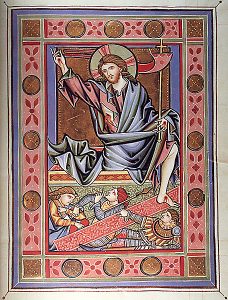
4. Rheinau Psalter, c. 1250 Zurich, Zentralbibliothek MS Rheinau 167, fol. 107r. Three soldiers, with eyes open, two looking up at Christ, one pointing toward him.
Largely the soldiers are sleeping, but some are awake, looking up toward the risen Christ, sometimes shielding their eyes (Fig. 4).

5. Coëytivy Hours, 1440-1449, Dublin, Chester Beatty Library MS W.82, fol. 342v. A soldier with his back turned rests comfortably on a red bolster with a gold tassel.
They wear chain mail or armor that is medieval, not Roman, which they would likely have been. Many are accompanied by weapons and shields, sometimes decorated with quasi-heraldic ornament. Some have creature comforts, such as a bolster to sit on, or a mattress to lie on (Fig. 5).
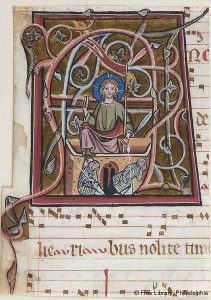
6. Antiphonary Fragment, c. 1300, Philadelphia Free Library MS Lewis EM 44.15. Christ steps from the tomb onto the neck of a sleeping soldier.
They pass the night at the tomb; they sleep even though Christ occasionally steps on them while climbing out of the tomb (Figs. 6 and 7); and they are still asleep when the three Marys, or Holy Women, arrive the next morning carrying ointment jars and sometimes censers.

7. Missal of Henry of Chichester, c. 1250, Manchester, John Rylands University Library, MS lat. 24, fol. 152v. Christ steps on one of two dark-skinned soldiers asleep before the tomb.
Signs of “otherness” appear: a distorted face with a pig-like snout for a nose; knotted headdresses; curved swords or scimitars; dark skin (Fig. 7). The tomb itself may be a plain sarcophagus; or it may look more like a medieval shrine, with openings in the base.
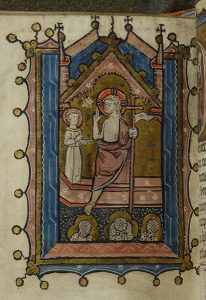
8. Psalter, c. 1290, New York, Morgan Library, MS M.34, fol. 187v. Each of three soldiers is tucked into an opening below the tomb.
Instead of pilgrims trying to get closer to the relics inside, the soldiers use those openings for cozy sleeping spaces (Fig. 8).
Judith K. Golden
On May 19-20, 2017, international and US Scholars will gather at Princeton to examine the near-intact monastic treasury of San Isidoro in Leon, in northern Spain, as a springing point for larger questions about sumptuary collections and their patrons across Europe and the Mediterranean across the Middle Ages. Topics of inquiry include Islamic law and sumptuary production, Christian manuscripts and metalwork, patronage and royal studies, identity and gender studies, and cultural and political history. The diversity of questions and perspectives addressed by the speakers will shed light on the nature of Leon as a paradigmatic treasury collection, as well as on the broad efficacy of multidisciplinary study for the Middle Ages.
Follow the link below for a full schedule and (free) registration information. We hope to see you there!

In medieval terms, March 25 was about as symbolically busy as a day could get. Already noted in the Julian calendar as the date of the vernal equinox, it is identified in the Golden Legend of the chronicler and archbishop Jacopo da Voragine as the date of an unusual number of auspicious Biblical events: Adam’s and Eve’s fall into sin; Cain’s murder of Abel; Abraham’s near-sacrifice of Isaac; Melchisidek’s offering of bread and wine to Abraham; the martyrdom of John the Baptist; the deliverance of Saint Peter; the martyrdom of Saint James the Great; and the Crucifixion. Still more strongly associated with this date was the Annunciation, at which, according to Luke 1:26-28, the archangel Gabriel brought word to the Virgin Mary that she would conceive the son of God: “And in the sixth month, the angel Gabriel was sent from God into a city of Galilee, called Nazareth, to a virgin espoused to a man whose name was Joseph, of the house of David; and the virgin’s name was Mary. And the angel being come in, said unto her: Hail, full of grace, the Lord is with thee: blessed art thou among women.”
Gabriel’s announcement to Mary inaugurated the Christological narrative that governed all the feasts of the liturgical year, so it is unsurprising that this event should be highlighted in medieval calendars, where its proximity to the start of spring also led many to treat March 25 as the beginning of the new year.
The Annunciation is among the most consistently depicted subjects in medieval iconography; it is found in everything from early Christian catacombs and sculpted facades to books of hours, mosaics, and panel paintings. Its composition and details vary in accordance with its setting: the Virgin might appear on a throne, in a loggia, in a bedroom, or outdoors, and she often is shown spinning or reading. A variant of particular interest is the depiction of the Annunciation at the Spring (as it is catalogued in the Index), also known as the Annunciation at the Well. Inspired by accounts preserved in early apocryphal texts such as the Protoevangelium of James and the Gospel of Pseudo-Matthew, this variant depicts the Virgin greeted by Gabriel as she is fetching water, the first of two successive meetings in which the angel delivers his news.

The Annunciation at the Spring emerged in late Antiquity and flourished in Byzantium and the visual traditions close to it. An early exemplar appears on a fifth-century plaque, possibly a book cover, now in Milan Cathedral Treasury. Here, a small square scene of the Annunciation initiates the narrative of Christ’s life; it depicts the Virgin Mary kneeling by a stream, pitcher in hand, as she looks back to receive the angel’s greeting. In a much later manuscript example, a twelfth-century Homilies of James Kokkinobaphos (Paris, BnF, MS gr. 1208, fol. 159v), two meetings are implied: at left, Mary dips her pitcher into a well as she turns to hear Gabriel’s message; at right, she approaches a house where she will receive the angel a second time.
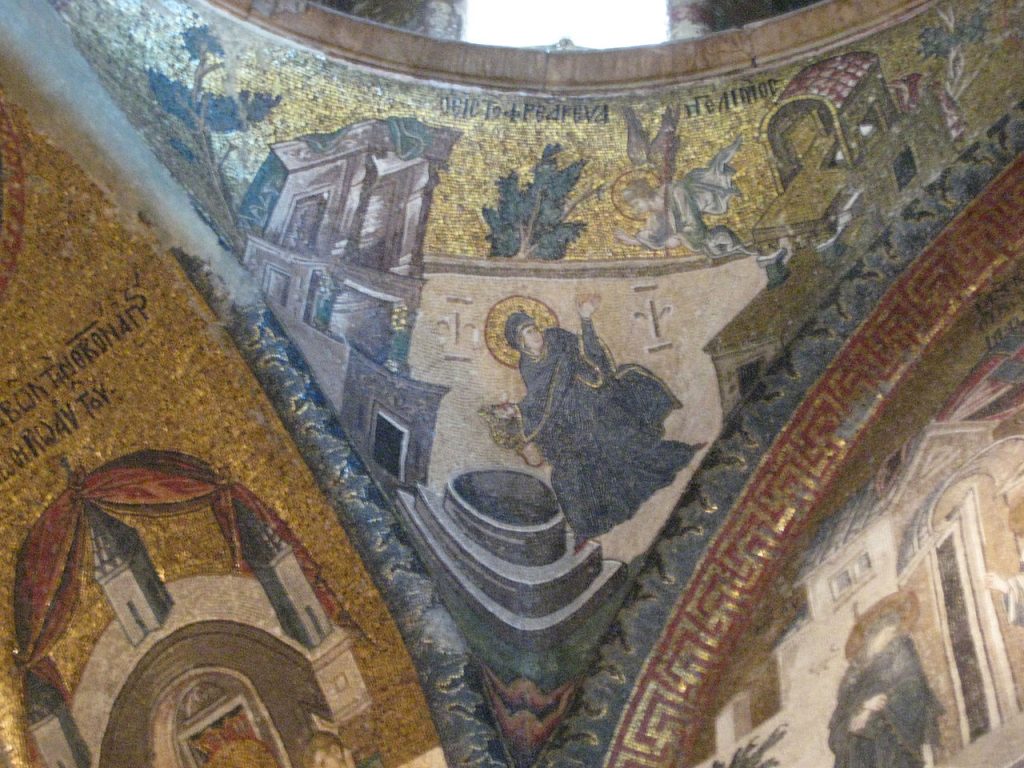
A more dynamic version of the well scene appears in an early fourteenth-century mosaic in the Church of the Savior at Chora in Istanbul: composed on a pendentive below one of the structure’s domes, it positions the angel as a fluttering visitor who descends the curved surface to greet Mary as she teeters over the well below.
Other cultures with close ties to Byzantine traditions also adopted the Annunciation at the Spring. The scene appears among twelfth-century mosaics of the Life of the Virgin in the transept of the church of San Marco in Venice, as well as in the early fourteenth-century Armenian manuscript known as the Glazdor Gospels (Los Angeles, University of California Research Library, MS. 1, p. 305).
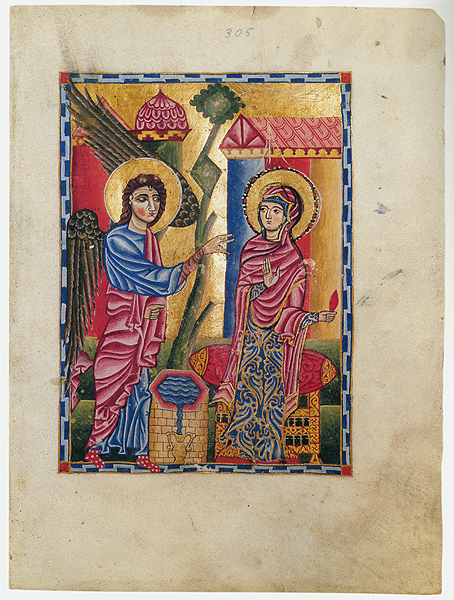
In the Gospels manuscript, a flattened, stylized well and pitcher offer only a vestige of the original iconography as they stand between Gabriel and the Virgin. The figures’ static postures, animated only by Gabriel’s speaking gesture and the Virgin’s raised palm, recall western Annunciation scenes, but Mary’s gilded brocade and the ogival dome at the top of the composition attest to its eastern roots.

The medieval church season of Lent officially opened with Ash Wednesday, the Wednesday after Quinquagesima Sunday (the period of fifty days before Easter). The observance of Ash Wednesday marked forty fast days before Easter, not counting Sundays. During Lent, medieval Christians were forbidden to consume meat, eggs, dairy and animal fats, except on the permitted Sundays which were viewed as a “mini-Easter.” By adding a level of restraint to their daily lives, medieval Christians fulfilled a call for penance, which was especially important during the Lenten season. On Ash Wednesday, in the Middle Ages as it is now, a celebration of Mass incorporated the distribution of blessed ashes on the foreheads of believers. When dispensing the ashes, the celebrant reminds those receiving it that “as you are from dust, from dust you shall return” (based on Genesis 3:19).

The Index records three examples in manuscript illumination of the distribution of ashes. Each begins a part of a liturgical book read for this feast: a Gradual fragment in Princeton University Library (Kane 13), a Gradual in the Morgan Library (M.933), and a Missal in the Walters Art Museum (W.174). The Morgan and Princeton Graduals begin with the same Latin Introit, “Misereris omnium domine et nichil odisti eorum…” (Thou hast mercy upon all, O Lord, and hatest nothing…). It is interesting to note that the subject heading “Scene, Liturgical: Distribution of Ashes” used by the Index now was not in the original card file but was developed sometime during the last twenty years when post-1400 material was incorporated into the Index.


Episodes from the life of Saint Blaise: Saint Blaise living with animals; extracting the fishbone; restoring the pig, and martyred with steel combs. Vitae Sanctorum, Anjou, 14th c. (Bib. Vat., MS lat. 8541), fol. 52v.
February 3 in the Roman Catholic calendar and February 11 in the Orthodox one mark the feast day of Saint Blaise, Bishop of Sebaste in Armenia in the early fourth century. According to his hagiography, Blaise had been trained as a physician before becoming a bishop in the early Christian church, an institution still outlawed in the Roman Empire. Seeking solitary prayer in the wilderness, he lived peacefully with the wild animals until his arrest by Roman soldiers on the orders of the Roman governor Agricola, under whom he was imprisoned, tortured, and martyred. Blaise’s best known miracles include his restoration of a pig to a woman from whom it was stolen by a wolf who returned it on the saint’s command, and the cure of a boy who was choking on a fishbone. This second miracle resulted in Blaise’s designation as the patron saint of those suffering from throat ailments, inspiring the annual tradition of the Blessing of the Throats on Saint Blaise’s Day, also known in the west as Candlemas.
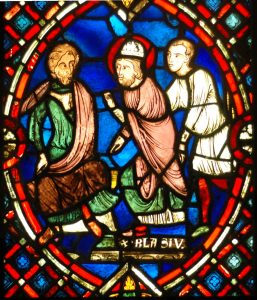
Saint Blaise before Agricola, detail of a stained glass window from the Soissons region, first quarter of the 13th c (Louvre, OAR 504).
In the Index of Christian Art, Blaise is catalogued as “Blasius of Sebaste.” He is typically depicted wearing his bishop’s robe and miter and holding a crozier. In later medieval art, he often holds a wool carder’s comb, perhaps a medieval reinterpretation of the Roman steel combs with which his flesh is said to have been raked during his martyrdom. Post-medieval images sometimes depict him holding two crossed candles in an allusion to the Blessing of the Throats. His most common narrative depictions show him meditating or ministering among the wild beasts; extracting the fishbone from the choking boy; standing before Agricola; or in the act of martyrdom, sometimes accompanied by the seven pious women who, according to Eastern tradition, followed him throughout his torments, wiping up his blood.
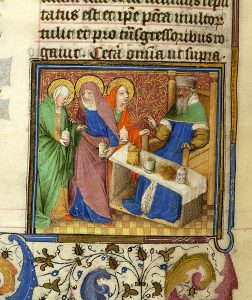
The marketplaces of medieval Europe were redolent of the spices that purportedly first arrived with returning Crusaders. A taste for the flavors of cinnamon, clove, nutmeg, ginger, pepper and the like created an increasing demand for spices that could not be grown in Europe’s climate but had to be imported from the East along secret trade routes, over land and sea. Distance was only one of several factors that affected the supply of spices, which were expensive and enjoyed only by those who could afford them. Nevertheless, as Paul Freedman writes in his blog “Spices: How the Search for Flavors Influenced our World,” the new taste for exotic flavors helped encourage world exploration and turn spices into global commodities.
The uses of spices were both culinary and medical, and medieval cookbooks and herbals reveal that spices were part of preferred regimens. Spices were taken together in varying combinations, sometimes seasonal. In the cold and wet winter months, it was advisable to eat spices in strongly flavored food and drink to warm the body. Maguelonne Toussaint-Samat notes in her History of Food that the physician Arnau de Villanova (c. 1240-1311) recommended balancing the four humors of the body by consuming spices “proper for winter” as zesty sauces of ginger, clove, cinnamon, and pepper (Toussaint-Samat, 486). These spices would aid digestion after a heavy winter meal by heightening the effects of “hot” and “humid” properties in roasted meats. To this day, the warming spices advocated by Arnau de Villanova tend to be associated with fall and winter.
Cameline sauce, perhaps the original steak sauce, was the perfect accompaniment to roast meats. Prepared in summer and winter months alike, the sauce was so popular in some locations, such as fourteenth-century Paris, that the blend was usually readily available from the local sauce maker. There were regional varieties of Cameline sauce, too, and the “Tournais style” involved grinding together ginger, cinnamon, saffron and half a nutmeg. The spice powder was soaked in wine and stirred together with bread crumbs. The strained mixture was then boiled, with sugar added to make the winter variety of the sauce. One recipe for Cameline sauce has been adapted by Daniel Myers for the Medieval Cookery web site and is reproduced here with permission.
Cameline Sauce
3 slices white bread
3/4 cup red wine
1/4 cup red wine vinegar
1/4 tsp. cinnamon
1/4 tsp. ginger
1/8 tsp. cloves
1 tbsp. sugar
pinch saffron
1/4 tsp. saltCut bread in pieces and place in a bowl with wine and vinegar. Allow to soak, stirring occasionally, until bread turns to mush. Strain through a fine sieve into a saucepan, pressing well to get as much the liquid as possible out of the bread. Add spices and bring to a low boil, simmering until thick. Serve warm.
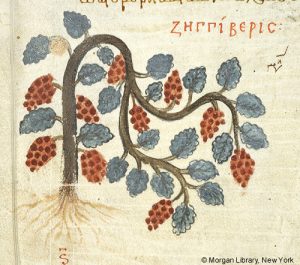
Ginger came to be highly prized during the Middle Ages, though the use of ginger can be traced back thousands of years in India and China. The potent ginger plant and rhizomes were valued for their stomach-warming and digestive properties as much as for the flavors they imparted. The first-century Greek physician Dioscorides advocated consuming a spicy Arabian plant called ζιγγίβερις (zingiberis), which was probably ginger, to “soften the intestines gently.” In Arabia, Dioscorides noted, they used only the freshest ginger plants (O’Connell 116-117).
Clove was known as one of the “lesser spices.” Though not as strong as ginger but useful for its antiseptic and anti-inflammatory properties, clove was especially useful in dental care.
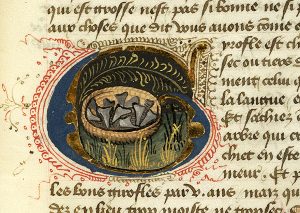
Named in English and other languages—“clou de girofle” in French—for the resemblance of the bud to nails, clove originated in the Moluccan Islands of Indonesia, the historical core of the Spice Islands. As with ginger, clove had its earliest uses in India and China in the fourth-century BCE, finding its way to Roman and Greek markets by way of port cities on the Mediterranean. By the eighth century, clove was known throughout Europe and features in several historic dishes. It was also a typical spice in pomanders, the medieval precursor to potpourri, in which fragrant ingredients were placed in a perforated box to ward off illness. The decorative use of clove-studded oranges, a seasonal pomander, is still associated with the winter months.

Hippocras, or hypocras, was a medieval spiced wine and popular cordial enjoyed especially during the winter holidays for several centuries. Hippocras was a concoction of powdered cinnamon, cassia buds, ginger, grains of paradise and nutmeg boiled with sugar and wine. Cinnamon, the essential flavor of hippocras, was a favorite spice of the medieval palate. Its mysterious origins generated many fanciful tales and even several expeditions. Perhaps most famously, the Genoese explorer Christopher Columbus thought he had located the spice in America—the Indies to him— and in 1493 he reportedly brought back bits of bark from a perfumed wild cinnamon tree that was not very tasty.
Long before Columbus, the ancient Egyptians had prized cinnamon as the “… goodly fragrant woods of The Divine Land…” while medieval Arabs believed that large birds used cinnamon sticks in their nests (O’Connell, 76-77). In the first century, the Roman natural philosopher Pliny the Elder rightly located the origin of cinnamon on the shores of the Indian Ocean. With information from some seasoned merchant, perhaps, Pliny knew that the cinnamon trade was dangerous and that a return trip to the source of the spice took almost five years. Pliny’s claims about the origin of cinnamon were eventually verified in the 1340s when the Moroccan explorer Ibn Battuta (1304–c. 1368) arrived at the island of Sri Lanka (formerly Ceylon) and discovered untouched miles of the cinnamon tree. Before its widespread appreciation as a culinary ingredient, cinnamon was prized in several ancient cultures as incense holding ritualistic importance, sometimes burned for its fragrance on a funeral pyre.
The final “proper” winter spice is pepper. With a name widely applied to many spices, including the black and white varieties, pepper was perhaps the most familiar spice of the Middle Ages. Both black pepper and white pepper are obtained from the small berries of the Piper nigrum vine.
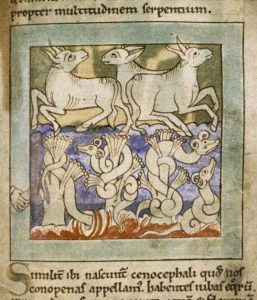
Unripe berries are green, and ripe berries are red. Dried ripe berries yield white pepper, and despite the fantastic medieval legend propagated by Isidore of Seville (560–636) that the scorching of pepper crops blackened the berries and drove out the poisonous guard snakes, unripe pepper berries are simply plucked, gathered, cooked, and then dried to give us the most familiar variety, black pepper. The principal traders of pepper came from India where the vines thrived in tropical regions. Pepper was used in medicine to aid digestion and to treat ailments like gout and arthritis, as well as infectious diseases like the bubonic plague.
The term “peppercorn rent” derives from the practice established in early common law in England that payment of rent or tax might be made by a peppercorn, to avoid the bother of exchanging real currency. Usually no peppercorns were actually collected during these transactions, but the spice represented a hard asset, and the term is still in use today in legal parlance to describe a token amount of rent money paid in order to keep a title alive. In all seasons, spices and their increasingly globalized trade during the Middle Ages affected medieval economies, and brought social, culinary, and health benefits to Europe. To this day, the flavors and aromas of medieval markets spice up the long, cold winter months.
Sources
Paul Freedman, “Spices: How the Search for Flavors Influenced Our World,” The YaleGlobal Online Blog, March 11, 2003, http://yaleglobal.yale.edu/content/spices-how-search-flavors-influenced-our-world.
Daniel Myers. “Cameline Sauce.” Medieval Cookery. Last modified July 13, 2006. http://medievalcookery.com/recipes/cameline.html.
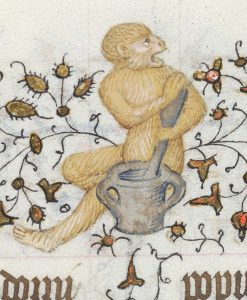
Freedman, Paul. Out of the East: Spices and Medieval Imagination. New Haven: Yale University Press, 2008.
Toussaint-Samat, Maguelonne. A History of Food. Translated by Anthea Bell. Oxford: Wiley-Blackwell, 2009.
Leah Hyslop, “Where do Christmas spices come from?” The Telegraph.co.uk (blog), December 22, 2015, http://www.telegraph.co.uk/gardening/grow-to-eat/where-do-christmas-spices-come-from/
O’Connell, John. The Book of Spice: From Anise to Zedoary. London: Profile Books, 2015.
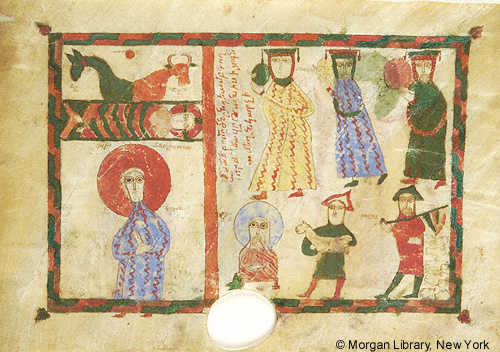
As friends and colleagues around the world prepare to celebrate festivals of light, we at the Index wish you all a luminous holiday season and a peaceful, prosperous New Year.